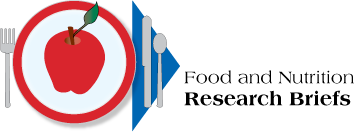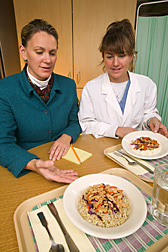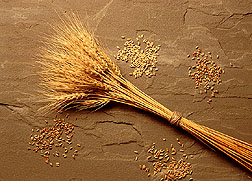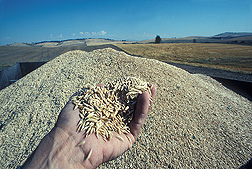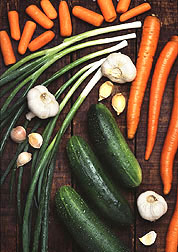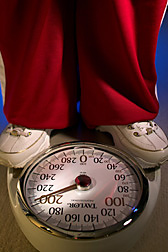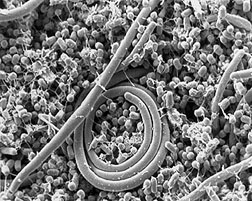| April 2006 |
Dieting? Get Your Copper!
|
|
Eating foods that provide, by day’s end, about three times the recommended daily amount of copper may help overweight or obese women retain calcium in their bones while they’re dieting.
That's indicated by a study with overweight women aged 25 to 35.
Some of the women in the study received daily supplements of 3 milligrams (mg) of copper. The others received supplements of only 1.23 mg.
All participants were then put on a weight-loss diet for four months.
Women who took 3 mg of copper retained more calcium in their bones than those who took 1.23 mg of supplemental copper.
The current Recommended Dietary Allowance for copper is 0.9 mg for women older than 19 years.
The copper study, conducted by scientists at the ARS Grand Forks (N.D.) Human Nutrition Research Center, suggests the current allowance for copper may not be adequate during weight loss.
For details, contact: Henry C. Lukaski, (701) 795-8429; USDA-ARS Grand Forks Human Nutrition Research Center, Grand Forks, N.D.
|
|
How Do Whole-Grain Foods Fight Fat?
Whole-grain foods like crunchy, whole-wheat toast are already known to help keep the body's levels of certain fats in check. A preliminary study by scientists with the Agricultural Research Service’s Western Human Nutrition Research Center, Davis, Calif., suggests whole-grain foods might do that by affecting VLDLs, or very-low-density lipoproteins, that transport fat in the blood.
For the investigation, 10 healthy female volunteers, aged 20 to 45, completed a short stint featuring whole-grain foods, and another featuring refined-grain selections.
Each stint was followed by a test breakfast at the laboratory. Volunteers gave a blood sample before breakfast and at three intervals later in the day.
Scientists found two significant differences in VLDLs. First, volunteers' VLDLs had higher levels of a kind of fat, known as a triglyceride, following the refined-grains test breakfast than following the whole-grains test meal.
Second, volunteers' VLDLs had a higher amount of another worrisome compound—this one known as apoCIII (short for apolipoprotein CIII)—following the refined-grains breakfast.
In medical studies, higher levels of triglycerides and of apoCIII have been associated with higher risk of heart disease.
A longer, larger followup study is planned for later this year.
For details, contact: Nancy L. Keim, (530) 752-4163; USDA-ARS Western Human Nutrition Research Center, Davis, Calif.
|
|
Whole Grains Again Linked to Good Health
Older adults who ate nearly three servings of whole-grain foods daily were significantly less likely to die from heart disease than those who ate fewer servings.
That’s according to a study conducted by researchers at the ARS Jean Mayer USDA Human Nutrition Research Center on Aging at Tufts University, Boston, Mass., and their colleagues, and published in the January 2006 issue of the American Journal of Clinical Nutrition (volume 83, pages 124 to 131).
They based their findings on their 1981-1984 analysis of three-day food records and blood tests from 535 healthy male and female participants older than 60, and their 12- to 15-year follow-up to assess the causes of death among participants during those years.
When sorted into groups according to the amount of whole-grain foods they ate, those who ate the most—an average of about 2.9 servings a day—had significantly less risk of dying from heart disease than those in the group with the lowest intake. (Whether the participants changed their preference for whole grains during the follow-up period is not known.)
The scientists concluded that adults of all ages should increase the amount of whole grains they eat to three servings a day—the recommended level—or even more.
Today, most Americans eat less than one daily serving of a whole-grain food.
For details, contact: Paul F. Jacques, (617) 556-3322; ARS Jean Mayer USDA Human Nutrition Research Center on Aging at Tufts University, Boston, Mass.
HiFi: A Very Heart-Healthy Oat
"HiFi,” a superior oat developed by Agricultural Research Service scientists in Fargo, N.D., and their university colleagues, boasts bountiful amounts of a healthful, soluble fiber called beta-glucan (Crop Science, volume 45, page 1664). In fact, HiFi, short for "High Fiber," provides 50 percent more beta-glucan than whole-oat products now sold in supermarkets.
Combined with well-balanced meals, beta-glucan can help lower blood levels of bad (LDL) cholesterol, thus lessening the risk of heart disease.
Health-label claims now permitted for foods containing beta-glucan have generated new interest in HiFi, which was first made available several years ago.
For details, contact: Douglas C. Doehlert, (701) 239-1413; USDA-ARS Red River Valley Agricultural Research Center, Fargo, N.D.
|
|
Veggies Help Young Girls Manage Their Weight
Eating veggies—low in calories and an excellent source of fiber—may help preteen girls maintain a healthy weight. That’s indicated in a study by Children’s Nutrition Research Center scientists at Houston, Texas, and their colleagues.
Analysis of food records completed by 114 African-American girls aged 8 to 10 showed that those who reported eating more vegetables had healthier BMI (Body Mass Index) scores (Obesity Research, volume 12 (Suppl.), pages 53S to 63S).
Preteen African-American girls have potentially higher-than-normal obesity rates and may be at a greater risk of heart disease, some cancers, diabetes and stroke when they grow up.
Parents can help their daughters by serving veggies at meals and keeping a variety of low-calorie veggie snacks handy in the refrigerator.
For details, contact: Karen W. Cullen, (713) 798-6764; USDA-ARS Children’s Nutrition Research Center, Houston, Texas.
|
|
Dieters Helped by Group Support
Dieters who have the help of a support group may experience less stress and less of a brainpower drain than those who go it alone, research suggests. Scientists with the Agricultural Research Service’s Western Human Nutrition Research Center, Davis, Calif., and their ARS-funded colleagues reported this in Psychoneuroendocrinology (volume 30, pages 908 to 918).
Fifty-six healthy, overweight women aged 23 to 45 completed the study, participating for eight weeks in either supervised or unsupervised weight-loss regimens or in a group that neither dieted nor met as a team.
Dieters who attended weekly support-group sessions did not have a significant increase in cortisol, a stress-associated hormone, at the end of the study's first week. Nor did the nondieting volunteers. But the unaided dieters did.
In addition, at that same checkpoint, the unassisted dieters scored lower in two computerized tests of their working-memory capacity—one aspect of mental performance—than did the supervised and the nondieting volunteers.
Even though there were no significant differences among volunteers' mental performance scores by the four- and eight-week checkpoints, the differences noted at the end of the first week nonetheless interest researchers and healthcare professionals who want to help dieters reduce weight-loss-associated stress and mental performance problems. Either or both kinds of problems—and the earliness with which they occur during dieting—may lead dieters to quit their weight-loss programs too soon.
For details, contact: Molly Kretsch, (301) 504-4788; USDA-ARS National Program Staff, Beltsville Md.
Gene Variants Linked to Storing—Not Burning—Fat
|
|
Two variants of a gene that is already associated with obesity and type 2 diabetes have now been implicated in storing excess fat in Caucasian women. The gene contains instructions that the body uses to form a protein known as perilipin.
At the ARS Jean Mayer USDA Human Nutrition Research Center on Aging, Tufts University, Boston, Mass., researchers studying the gene in 361 women volunteers found that those with variants 13041A/G and 14995A/T tended to have a higher percentage of body fat and a bigger waistline than women with the other two variants (Obesity Research, volume 12, pages 1758 to 1765).
Researchers now regard these two inherited variants as significant predictors of obesity in women.
For details, contact: Jose M. Ordovas, (617) 556-3102 or Andrew Greenberg, (617) 556-3144; ARS Jean Mayer Human Nutrition Research Center on Aging at Tufts University, Boston, Mass.
Weight-Loss Secret: Perseverance, Not Diet Type, Matters Most
Persevering with a weight-loss regimen is more important than the type of diet selected, when it comes to losing weight. That’s the conclusion from a study of 160 overweight or obese volunteers assigned randomly to one of four popular diets—Atkins, Ornish, Weight Watchers, or Zone—for one year.
Tufts University scientists, funded in part by the Agricultural Research Service, provide details in a 2005 issue of the Journal of the American Medical Association (volume 293, pages 43 to 53).
All volunteers who completed the 12-month regimen achieved a modest but significant weight loss and a 10-percent improvement in their ratio of good (HDL) to bad (LDL) cholesterol—regardless of diet type.
Only about half of the volunteers following what the scientists regard as the more extreme diet plans—Atkins and Ornish -- completed the study.
The findings show how important it is for dieters to choose a weight-loss plan that matches their food preferences, lifestyle and health.
For details, contact: Ernst J. Schaefer, (617) 556-3100; ARS Jean Mayer USDA Human Nutrition Research Center on Aging at Tufts University, Boston, Mass.
Study Pinpoints Habits That Can Make You Fat
|
|
People who watch more than two hours of television a day are twice as likely to be overweight than those who do not, an analysis of the lifestyles and eating habits of more than 8,500 American adults suggests.
Other habits—little and big—that can contribute to overweight include eating more total fat and saturated fat than normal-weight folks do, eating chicken without first removing the skin, skipping breakfast and, of course, not exercising.
Agricultural Research Service scientists at the Beltsville (Md.) Human Nutrition Research Center found these and other correlations in their analysis of 1994 to 1996 USDA nutrition-monitoring data, and reported their findings in a chapter of Body Mass Index: NewResearch, (Nova Science Publishers, Inc., pages 117 to 140).
An estimated 64 percent of all American adults are overweight or obese. And nearly 9 million of our children aged 6 years or older are also obese.
For details, contact: Shanthy A. Bowman, (301) 504-0619; USDA-ARS Beltsville Human Nutrition Research Center, Beltsville, Md.
|
|
Added Sugars Noted in New Database
Interested in checking the amount of sugars added to your favorite foods?
Then you’ll want to take a look at USDA Database for the Added Sugars Content of Selected Foods, a new, online source of information about the added sugars, total sugars and carbohydrates in more than 2,000 common foods.
You can view it on the World Wide Web at: /Services/docs.htm?docid=12107.
Scientists at the Agricultural Research Service’s Beltsville (Md.) Human Nutrition Research Center produced the online database.
Americans eat about 23 teaspoons of added sugars every day, totaling 460 calories.
For details, contact: Joanne M. Holden, (301) 504-0630; USDA-ARS Beltsville Human Nutrition Research Center, Beltsville, Md.
Soybean Glyceollins—Breast Cancer Fighter?
Tomorrow’s soybeans might produce impressive quantities of glyceollins—compounds that, in laboratory tests, blocked growth of hormone-dependent human breast cancer cells.
ARS scientists with the Southern Regional Research Center, New Orleans, La., have shown that soybean seeds—and newly-sprouted soybeans—will produce glyceollins as a defense response to attack by harmful microbes.
Now the researchers want to coax soybeans do to that routinely, for large-scale production of the glyceollins.
For details, contact: Stephen M. Boué, (662) 915-2019; USDA-ARS Southern Regional Research Center, c/o USDA-ARS Natural Products Utilization Research Unit, University, Miss.
Salmonella Test May Reduce Meat and Produce Recalls
Salmonella lurking in ready-to-eat meats can be readily detected with a new, still-preliminary test developed by Agricultural Research Service scientists based in Beltsville, Md. The assay relies on PCR (polymerase chain reaction) technology to detect the food-contaminating microbe.
The test can detect Salmonella even at very low levels, and it's less expensive than a commercial rapid-detection test currently in use. Both tests can be performed within an 8-hour incubation period, or one work shift, meaning that contamination could be detected before a product such as bologna, turkey or ham slices, or a mixed salad, is shipped. In turn, that could reduce product recalls.
For details, contact: Jitu Patel, (301) 504-7003; USDA-ARS Henry A. Wallace Beltsville Agricultural Research Center, Beltsville, Md.
The U.S. Department of Agriculture (USDA) prohibits discrimination in all its programs and activities on the basis of race, color, national origin, age, disability, and where applicable, sex, marital status, familial status, parental status, religion, sexual orientation, genetic information, political beliefs, reprisal, or because all or part of an individual's income is derived from any public assistance program. (Not all prohibited bases apply to all programs.) Persons with disabilities who require alternative means for communication of program information (Braille, large print, audiotape, etc.) should contact USDA's TARGET Center at (202) 720-2600 (voice and TDD). To file a complaint of discrimination, write to USDA, Director, Office of Civil Rights, 1400 Independence Avenue, S.W., Washington, D.C. 20250-9410, or call (800) 795-3272 (voice) or (202) 720-6382 (TDD). USDA is an equal opportunity provider and employer. |

